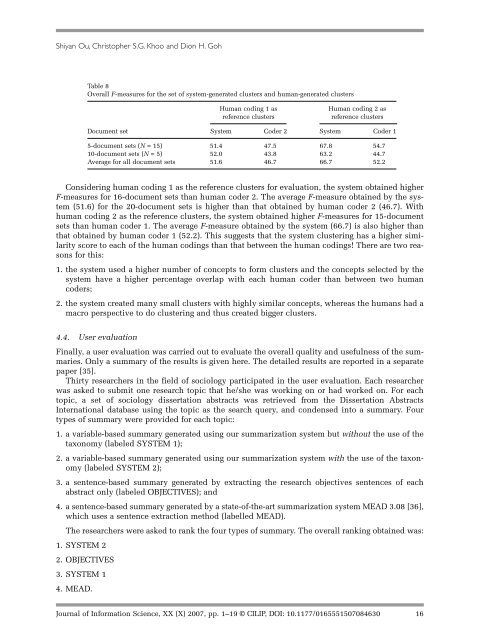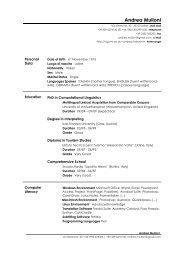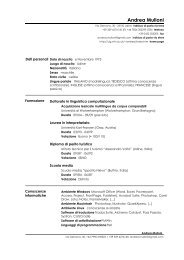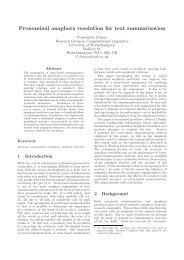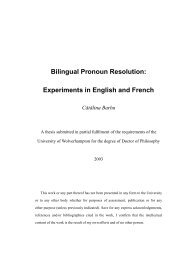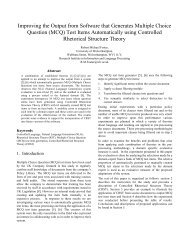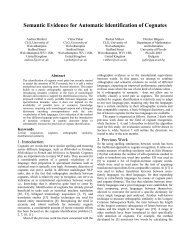Design and development of a concept-based multi ... - Citeseer
Design and development of a concept-based multi ... - Citeseer
Design and development of a concept-based multi ... - Citeseer
Create successful ePaper yourself
Turn your PDF publications into a flip-book with our unique Google optimized e-Paper software.
Shiyan Ou, Christopher S.G. Khoo <strong>and</strong> Dion H. Goh<br />
Table 8<br />
Overall F-measures for the set <strong>of</strong> system-generated clusters <strong>and</strong> human-generated clusters<br />
Human coding 1 as Human coding 2 as<br />
reference clusters reference clusters<br />
Document set System Coder 2 System Coder 1<br />
5-document sets (N = 15) 51.4 47.5 67.8 54.7<br />
10-document sets (N = 5) 52.0 43.8 63.2 44.7<br />
Average for all document sets 51.6 46.7 66.7 52.2<br />
Considering human coding 1 as the reference clusters for evaluation, the system obtained higher<br />
F-measures for 16-document sets than human coder 2. The average F-measure obtained by the system<br />
(51.6) for the 20-document sets is higher than that obtained by human coder 2 (46.7). With<br />
human coding 2 as the reference clusters, the system obtained higher F-measures for 15-document<br />
sets than human coder 1. The average F-measure obtained by the system (66.7) is also higher than<br />
that obtained by human coder 1 (52.2). This suggests that the system clustering has a higher similarity<br />
score to each <strong>of</strong> the human codings than that between the human codings! There are two reasons<br />
for this:<br />
1. the system used a higher number <strong>of</strong> <strong>concept</strong>s to form clusters <strong>and</strong> the <strong>concept</strong>s selected by the<br />
system have a higher percentage overlap with each human coder than between two human<br />
coders;<br />
2. the system created many small clusters with highly similar <strong>concept</strong>s, whereas the humans had a<br />
macro perspective to do clustering <strong>and</strong> thus created bigger clusters.<br />
4.4. User evaluation<br />
Finally, a user evaluation was carried out to evaluate the overall quality <strong>and</strong> usefulness <strong>of</strong> the summaries.<br />
Only a summary <strong>of</strong> the results is given here. The detailed results are reported in a separate<br />
paper [35].<br />
Thirty researchers in the field <strong>of</strong> sociology participated in the user evaluation. Each researcher<br />
was asked to submit one research topic that he/she was working on or had worked on. For each<br />
topic, a set <strong>of</strong> sociology dissertation abstracts was retrieved from the Dissertation Abstracts<br />
International database using the topic as the search query, <strong>and</strong> condensed into a summary. Four<br />
types <strong>of</strong> summary were provided for each topic:<br />
1. a variable-<strong>based</strong> summary generated using our summarization system but without the use <strong>of</strong> the<br />
taxonomy (labeled SYSTEM 1);<br />
2. a variable-<strong>based</strong> summary generated using our summarization system with the use <strong>of</strong> the taxonomy<br />
(labeled SYSTEM 2);<br />
3. a sentence-<strong>based</strong> summary generated by extracting the research objectives sentences <strong>of</strong> each<br />
abstract only (labeled OBJECTIVES); <strong>and</strong><br />
4. a sentence-<strong>based</strong> summary generated by a state-<strong>of</strong>-the-art summarization system MEAD 3.08 [36],<br />
which uses a sentence extraction method (labelled MEAD).<br />
The researchers were asked to rank the four types <strong>of</strong> summary. The overall ranking obtained was:<br />
1. SYSTEM 2<br />
2. OBJECTIVES<br />
3. SYSTEM 1<br />
4. MEAD.<br />
Journal <strong>of</strong> Information Science, XX (X) 2007, pp. 1–19 © CILIP, DOI: 10.1177/0165551507084630 16


